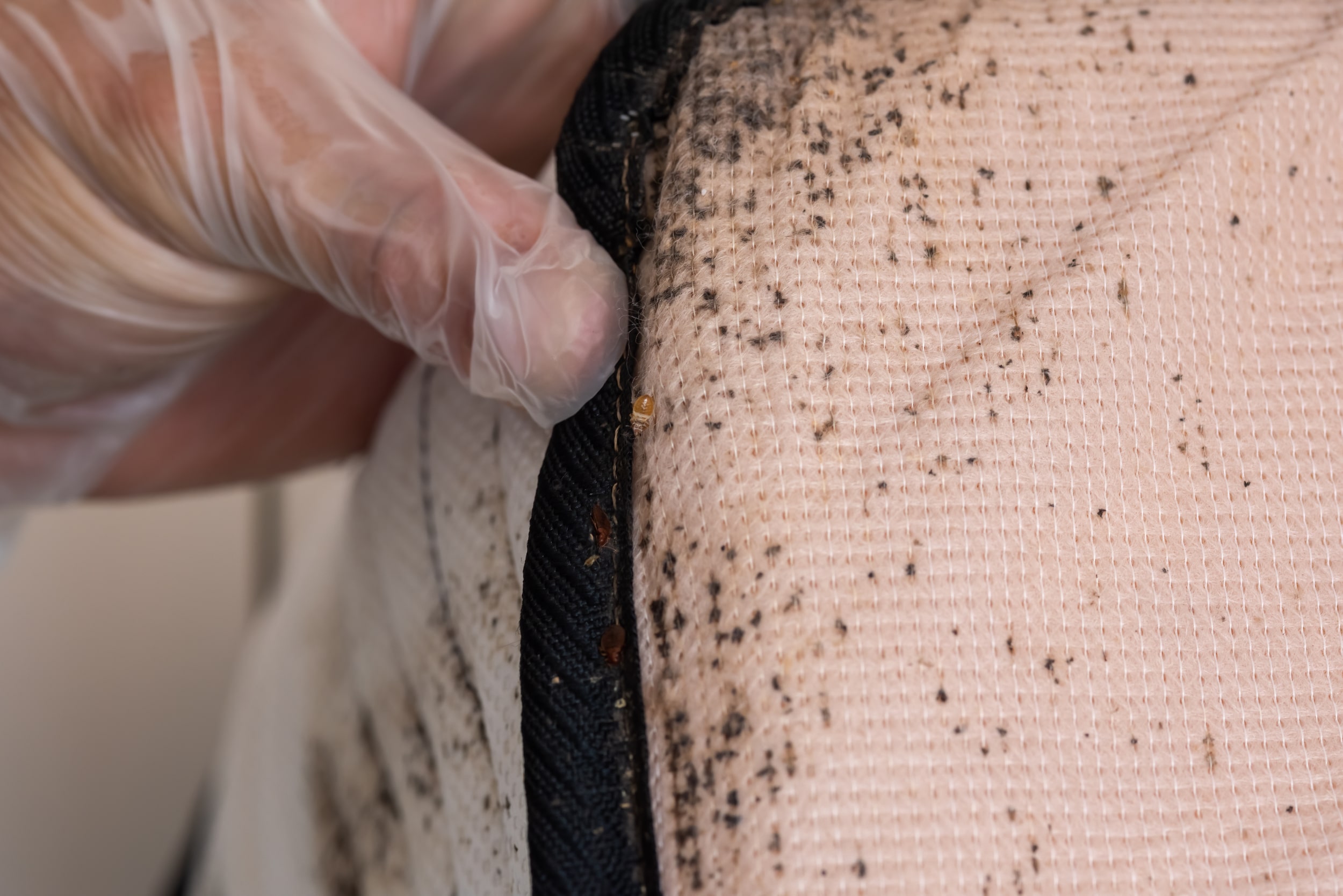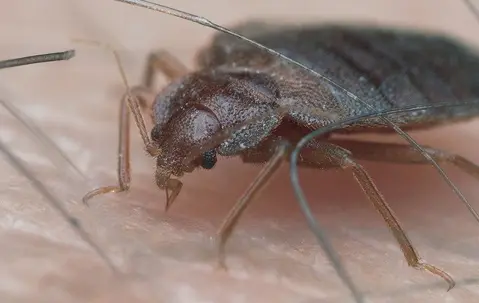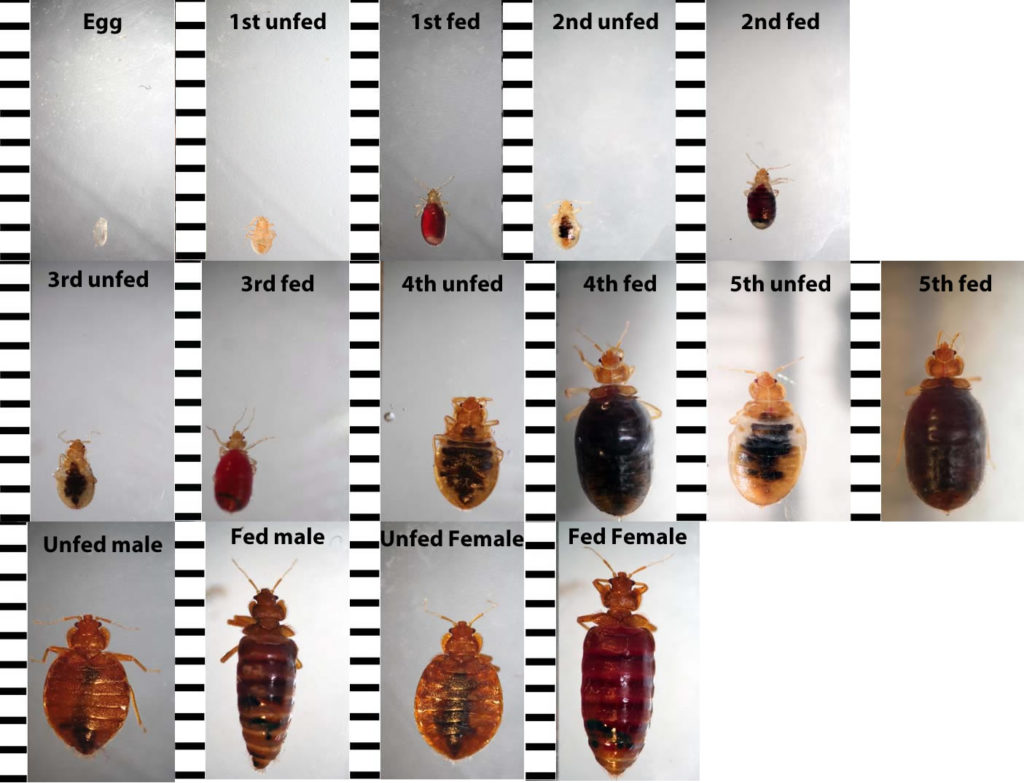Bed Bug Treatments in Florida
Exterminator Services for Fort Myers, Estero, and Immokalee
Florida’s subtropical climate—mild winters, steady warmth, and year-round humidity—draws many seeking comfort, yet it also nurtures certain persistent pests, most concerningly bed bugs. These discreet, blood-feeding insects often hide in mattress seams, behind baseboards, or within furniture folds during the day, emerging at night to feed on unsuspecting sleepers. In Fort Myers, along with neighboring Estero and Immokalee, even a minor bed bug introduction can become a notable infestation if occupant vigilance is lacking or the earliest warning signs—like small black specks on sheets or red bite welts on waking—go unnoticed. This service page explains why bed bugs endure so well in Florida, what alerts you to their presence, and why enlisting a professional bed bug exterminator for bed bug treatments ensures the most thorough removal. By intervening swiftly upon discovering suspicious bites or black dots on pillowcases, you preserve occupant comfort, avoid deeper infiltration, and re-establish restful nights free from these nocturnal intruders.
Why Bed Bugs Flourish in Florida

- Mild Winter Conditions
In colder states, sustained freezing weather inhibits bed bug activity for months, forcing them into slower reproduction or partial dormancy. Florida’s winter rarely endures such lows, letting bed bugs remain fully active year-round. Indoors, occupant or caretaker heating or cooling ensures stable temperatures—ideal for bed bugs to feed, mate, and lay eggs unless occupant housekeeping or professional solutions intervene. - Frequent Travel and Occupant Movement
Areas like Fort Myers, known for tourism, snowbird populations, or short-term rentals, see occupant transitions inadvertently carrying bed bugs in luggage or secondhand furniture. Even a single infested item can establish a new colony if occupant checks, such as scanning bedding corners or vacuuming newly acquired items, remain incomplete. Without occupant synergy or caretaker vigilance, bed bugs remain unnoticed until occupant bites become severe or black specks appear on sheets. - Minimal Seasonal Dormancy
In many regions, bed bugs slow or pause reproduction during harsh, freezing winters. Southwest Florida imposes no such forced dormancy, so bed bugs feed and breed if occupant or manager solutions fail to detect them early. A few overlooked bugs behind a headboard or in a couch seam can burgeon into an entire infestation if occupant synergy—like routine vacuuming or discarding clutter—does not hamper expansions. - Consistent Indoor Climates
Occupied buildings typically hover around 65–80°F, an ideal temperature range for bed bug development. Without occupant-based detection—like checking mattress seams or vacuuming floors—bed bugs remain inconspicuous, tucking away in cracks or upholstery edges until occupant sightings or bite patterns prompt professional help. - Short-Term Rentals or Frequent Visitors
In regions like Fort Myers, Estero, or Immokalee—where occupant transitions or secondhand commerce remain common—bed bugs can hitch rides effortlessly in personal items, concealed among folded blankets or used couches. Acting quickly if occupant sees black spots on bed linens or experiences new bites each morning ensures a small infiltration does not explode across multiple bedrooms or floors.
Signs of a Bed Bug Infestation
- Red, Itchy Bites or Welts
Bed bugs tend to feed while occupants sleep, leaving small, red bumps in lines or clusters on exposed skin—arms, legs, neck. Some individuals react strongly, experiencing itching welts, while others show minimal marks, making occupant or caretaker reliance on physical evidence—like droppings—crucial. Consistent morning bites with no apparent fleas or mosquitoes highlights bed bugs as a prime culprit. - Dark Spots or Rusty Stains on Bedding
After feeding, a bed bug may be accidentally crushed, leaving faint rust-colored smears on pillowcases or sheets. Additionally, bed bug feces appear as tiny black or brown dots near mattress corners, behind headboards, or along seam piping. Carefully lifting mattress edges often exposes these subtle stains, strongly implying active feeding. - Exoskeletons and Eggshells
As bed bugs grow from nymph to adult, they molt, discarding translucent exoskeletons. Their whitish eggs, roughly 1 millimeter in size, often cluster in hidden cracks near sleeping areas. Investigating bed frames, baseboards, or couch seams using a flashlight may uncover these shells, indicating ongoing bed bug reproduction. - Possible Musty or Sweetish Odor
Large colonies can produce a faint, musty smell from bed bug pheromones, though not every infestation becomes large enough for occupant detection by smell alone. Relying on occupant sightings—like black droppings or eggs—remains more accurate than odor if the colony remains moderate in size. - Live Bed Bugs
Adult bed bugs measure about 5–7 millimeters, flattened and oval, turning reddish-brown after a blood meal. Nymphs appear smaller and lighter. Observant occupant or caretaker may flip cushions or remove covers, causing them to scurry away from direct light. Spotting even one adult typically indicates more remain concealed behind furniture or in wall crevices.
Implications of Ignoring Bed Bugs
- Unhindered Population Growth
A single bed bug can deposit multiple eggs daily, hatching in about two weeks. In Florida’s mild environment, a minimal infiltration promptly balloons if occupant or caretaker fails to respond. Swift occupant synergy or professional measures block expansions across multiple rooms or floors. - Sleep Disruption and Anxiety
Individuals living with bed bugs often face ongoing bites or welts, leading to insomnia, stress, or repeatedly laundering linens. Eliminating them thoroughly reinstates occupant peace, letting families or staff revert to normal rest without the dread of nightly feeds. - Potential Spread to Neighbors
In multi-unit properties—like apartment complexes—bed bugs occasionally traverse wiring conduits or occupant belongings if occupant or building-level solutions remain incomplete. Coordinated occupant checks hamper expansions affecting multiple floors or entire buildings. - Reduced Rental or Hospitality Ratings
For short-term rental owners or hotels in Fort Myers, occupant or guest encounters with bed bugs can damage reputations, driving negative reviews or occupant reluctance to return. Quick occupant or caretaker synergy ensures occupant trust remains solid, preserving brand image and occupant loyalty.

Why a Professional Exterminator is Indispensable
- Detailed Property Inspection
A bed bug exterminator carefully surveys mattresses, box springs, upholstered seating, plus corners or cracks near sleeping areas for eggs, droppings, or adult bugs occupant alone might overlook. Confirming bed bug presence (versus fleas or roaches) clarifies which extermination route—steam, insect growth regulators, or whole-structure heat—best fits the scenario. - Eliminating All Life Stages
Bed bugs exist in eggs, nymphs, and adult forms. Removing only adults leaves eggs behind. Professionals integrate multi-step methods—like vacuuming, steam, or entire-building heat—to kill bed bugs at each phase, preventing re-infestation from newly hatched eggs occupant or caretaker might miss. - Accurate, Low-Risk Treatment
Over-the-counter foggers risk scattering bed bugs deeper into wall voids, possibly saturating occupant areas with excess chemicals. Exterminators apply insect growth regulators or sprays directly to nest zones—mattress seams, baseboards, or furniture cracks—minimizing occupant overexposure while guaranteeing lethal coverage for bed bugs. - Follow-Up and Ongoing Checks
Since eggs hatch about two weeks after being laid, occupant or caretaker re-checks confirm newly emerged nymphs also face lethal conditions. If occupant sightings continue—like unexplained bites or fresh black droppings—spot treatments finalize occupant relief, ensuring no pockets remain behind walls or inside furniture.
Potential Approaches for Bed Bug Treatments
- Inspection and Identification
Professionals remove linens, shine flashlights on mattress seams, or lift cushions to detect droppings or exoskeletons occupant might overlook. Determining how extensive the infestation is—one room or multiple floors—shapes whether occupant-driven cleaning plus localized spraying suffices or if entire-building heat is advisable. - Vacuuming and Steam
Initially, vacuuming surfaces gathers adult bed bugs, eggs, and exoskeletons occupant might miss. Occupants discard vacuum contents sealed in plastic outdoors. Steam—extremely hot—kills bed bugs or eggs buried deeper in upholstery, surpassing normal chemical penetration. This synergy can drastically reduce population before occupant or caretaker moves to insecticidal steps. - Insect Growth Regulators (IGRs) and Residual Sprays
IGRs hamper egg or nymph development. Spraying or dusting them along baseboards, mattress corners, or furniture legs ensures bed bugs crossing these zones cannot mature or reproduce. Occupants typically wait for dryness or recommended intervals, returning to normal usage once products settle. - Whole-Structure Heat Treatments
For extensive or multi-room infestations, raising interior temperatures above ~120°F can exterminate bed bugs hiding behind walls, in electronics, or inside furniture simultaneously. Occupants briefly vacate while specialized heaters saturate the building. Once the temperature returns to normal, occupant re-enters a bed bug–free space. - Mattress Encasements and Interceptors
Sealing mattresses or box springs in protective covers denies bed bugs prime nesting locations. Interceptors placed under bed legs catch bed bugs trying to climb onto beds for feeding. Monitoring these traps reveals if any bed bugs remain post-extermination, prompting occupant synergy or caretaker checks if occupant sightings persist.
Serving Fort Myers, Estero, and Immokalee
Fort Myers: A major city known for tourism and occupant turnover in short-term rentals or seasonal residences. Bed bugs may ride in occupant luggage or secondhand furniture if occupant scanning is incomplete. Occupant synergy—like verifying bedding edges or vacuuming floors—plus a professional approach ensures expansions do not saturate entire floors or multi-room dwellings.
Estero: A suburban locale bridging older homes with new developments. Bed bugs can slip inside from occupant or caretaker oversights—like adopting used couches or occupant travel. Quick occupant recognition of red bites or black spots on sheets fosters occupant synergy with thorough bed bug solutions, halting multi-room infiltration.
Immokalee: A more rural or agricultural region. Bed bugs can migrate via occupant or caretaker transitions in personal items or move from farmworker housing lacking occupant dryness or housekeeping measures. Occupant synergy—like routine vacuuming or verifying used items—plus professional insect growth regulators or heat treatments ensure bed bugs cannot multiply behind walls or in lesser-used sleeping areas.

Why Our Bed Bug Treatments Outperform
- Florida-Adapted Tactics
Because southwestern Florida seldom experiences bed bug–stalling cold, occupant synergy—like scanning secondhand furniture or discarding clutter—plus advanced extermination—like steam, insect growth regulators, or entire-structure heat—address bed bugs from egg to adult. This synergy conquers near-constant breeding cycles effectively in a mild environment. - Precision with Minimal Chemical Exposure
We target bed bug hideouts—mattress seams, furniture folds—ensuring occupant or pet minimal chemical contact. Occupants typically wait only for dryness or recommended intervals, returning quickly to normal usage while bed bugs face lethal coverage in their crucial nesting spots. - Preventive Occupant Collaboration
Removing current bed bugs solves immediate problems, but occupant synergy—like sealing cracks, vacuuming carpets, verifying secondhand goods—keeps new introductions from reestablishing. This occupant plus professional approach cements stable, bed bug–free living or working spaces. - Follow-Up for Reassurance
Because bed bug eggs hatch roughly two weeks after being laid, occupant or caretaker re-checks ensure newly hatched nymphs meet lethal conditions. If occupant sightings persist—like unexplained bites or fresh black specks—further spot treatments finalize occupant peace, confirming no hidden group endures behind walls.
Next Steps
Seeing small, red bites upon waking, noticing black specks on linens, or spotting tiny insects scuttling behind couches? Contact us to learn more or schedule your service. Our bed bug exterminator solutions in Fort Myers, Estero, and Immokalee remove bed bugs from egg to adult, restoring occupant tranquility and restful nights. By intervening swiftly, occupant avoids deeper infiltration across multiple rooms, occupant unease, or the repetitive frustration of bites leading to continuous laundering cycles.
Combining occupant housekeeping—like laundering bedding on high heat, vacuuming floors thoroughly, discarding clutter or scanning secondhand items—and specialized bed bug treatments—like steam, insect growth regulators, or entire-structure heat—forces bed bugs into lethal contact at each phase. Freed from these nocturnal feeders lurking in mattress seams or wall crevices, southwestern Florida residents enjoy the region’s mild climate and local conveniences, unburdened by hidden insects waiting to disrupt occupant comfort after dark.
Sustaining a Bed Bug–Free Environment
- Inspect Secondhand Items: Before bringing used mattresses, sofas, or décor inside, check for black specks, eggs, or exoskeletons. If uncertain, vacuum or treat them offsite to prevent hitchhiking bed bugs from establishing new nests.
- Frequent Laundry of Linens: Washing sheets, pillowcases, or blankets weekly in hot water kills bed bugs or eggs clinging to fabrics. Drying on high heat finishes the job, removing any survivors.
- Vacuum Regularly: Weekly vacuuming of floors, rugs, and upholstered furniture picks up stray eggs or adult bed bugs occupant may not see. Dispose of vacuum contents sealed in plastic outside to keep them from returning.
- Use Mattress Encasements: Enclosing mattresses or box springs in bed bug–proof covers denies bed bugs a prime nesting area. Checking these encasements periodically for new droppings ensures occupant can spot resurgence quickly.
- Post-Travel Precautions: After trips or short-term rentals, occupant can launder clothes on high settings and vacuum suitcases. This occupant habit deters bed bugs from stowing away into personal spaces, saving occupant resources and occupant stress from potential fresh infestations.
By uniting occupant diligence—like vacuuming or scanning corners for droppings—and advanced, integrated pest management—like insect growth regulators, steam, or entire-building heat—bed bugs encounter lethal conditions at every life stage. Even in Florida’s mild winter climate that rarely curbs bed bug reproduction, occupant synergy plus a comprehensive extermination approach hamper these parasites effectively, protecting families, guests, and staff in Fort Myers, Estero, and Immokalee from the sleeplessness and bites inflicted by hidden bed bug populations.
